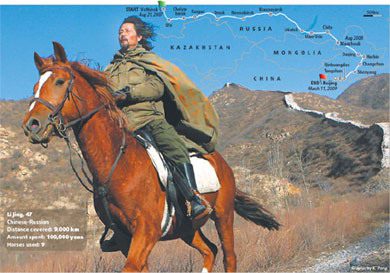 |
| Li Jing, China’s Greatest Long Distance Rider
and the Subject of My New Quest |
One of the great things about publishing articles on a blog or at places like Meridian Magazine (LDSmag.com) and The Interpreter is the connections it can lead to. Connections with new people sharing common interests or providing new insights makes the effort to write worth every moment. My recent article on horses in the Book of Mormon at Meridian Magazine led to a surprising letter from CuChullaine O’Reilly (CuChullaine is a Gaelic name, pronounced
Ka-kul-lun) and it is already taking me to surprising new places.
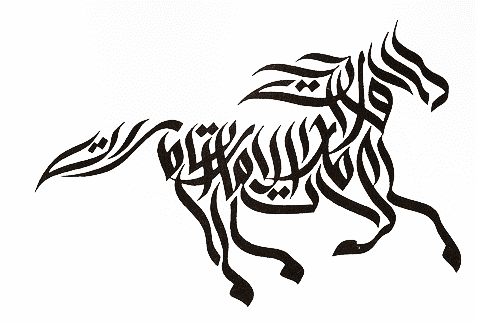 |
| Stunning Arabic Calligraphy:
A Verse from the Koran in the Form of a Horse |
With my correspondent’s kind permission, I gladly share some excerpts of our ongoing conversation:
Dear Mr. Lindsay, CuChullaine O’Reilly here. I am the Founder of the Long Riders’ Guild, the international association of equestrian explorers, and the author of “The Encyclopaedia of Equestrian Exploration.” http://www.thelongridersguild.com/Books/eee.htm
I have just received a news alert that contained a reference to the LRG. Upon investigating, I discovered that you had cited Wayne McCrory’s research linking Siberian and Canadian horses. I published Wayne’s paper, am very familiar with his genetic research, and have sent him the link to your article. I am unacquainted with the Book of Mormon and was unaware that questions regarding North American equines were of religious importance. However, as you so wisely noted, there is a great deal yet to be discovered and understood about the presence of horses in the Americas.
Because of my work documenting the history of Siberian and Spanish horses in exploration history, I am writing without delay so as to provide you with some immediate academic assistance. Here is an article, written in 1940 by the noted American equestrian scholar Thornton Chard. In this article, Chard argues that the first European horses brought to the New World did not survive. http://www.lrgaf.org/articles/spanish-horse-progeny.htm
Here is an article, written by a leading Canadian equestrian journalist, which documents the history and characteristics of Siberia’s Yakut horses. http://www.lrgaf.org/articles/yakut_horse.htm
Here is an interview I did with the renowned Long Rider Ian Robinson. He is the first person to make a modern equestrian journey in Siberia, where he confirmed that the horses in that region have the capability to enter into a state of semi-hibernation so as to retain heat and energy. http://www.thelongridersguild.com/stories/siberia.htm
Finally, here is an article I wrote which documents how meat-eating Siberian horses were employed in early attempts to reach the South Pole. http://www.lrgaf.org/polar-ponies.htm
Whereas I cannot offer an opinion about the appearance and use of horses in Mormon history, you are correct when you wrote that horse history is far from being settled. This idea was discussed only a few days ago when I corresponded with Dr. Alan Outram. In a recently published English news account, Alan, whom I had previously interviewed, told the press that he had found equine DNA in Central Asia that he believes may link what was thought to be an extinct breed of early horse to the Przewalski breed still alive today. http://www.independent.co.uk/news/science/horse-origin-mysterious-domestic-dna-analysis-przewalskis-botai-domesticated-a8224121.html
I wrote to Alan to explain that though he and other scientists believe that the ancient horse in question was thought to have disappeared many centuries ago, the Long Riders’ Guild has an image of a Turkman tribesman riding such a “extinct” horse in 1893! Thus “extinct” horses do have a way of wandering out of the shadows!
Kind regards, CuChullaine O’Reilly FRGS
I was delighted by the information he provided relevant to the horse (Thornton Chard’s detailed analysis of the date of Spanish horses raises many questions about the “common knowledge” belief that the horses of North American Native Americans after the Spanish Conquest necessarily came from the Spaniards). But I was even more delighted to make the acquaintance with someone who in a brief letter could convey such intelligence, civility, and romantic flare for one of the great traditions of mankind that has been largely lost in our day.
I responded with enthusiasm, thanking him for his work in this area and for sharing such welcome information. I added, “The horse is such an incredible creature and one whose history, ways, impact on man, etc., needs to be better understood in the automobile and iPhone era.”
Then came his delightful “lighting a rocket” email that truly captured my imagination regarding the work of the Guild:
Dear Jeff,
CuChullaine O’Reilly of the Long Riders’ Guild here, replying to your message regarding horses and the Book of Mormon.
Well I don’t know what kind of effect your article had on your normal readers but it certainly lit a rocket under the tail of the Long Riders’ Guild!
But before I comment on that intriguing topic, allow me to explain the mission of the Long Riders’ Guild, the world’s first international association of equestrian explorers and long distance travelers.
With Members in forty-six countries, every major equestrian explorer alive today belongs to the Guild, including Hadji Shamsuddin of Afghanistan, who recently rode a thousand miles through that war-zone, Jean-Louis Gouraud of France, who rode 3,000 miles from Paris to Moscow, Tim Cope of Australia, who rode 6,000 miles from Mongolia to Hungary, Claudia Gottet of Switzerland, who rode 8,000 miles from Arabia to the Alps, Adnan Azzam of Syria, who rode 10,000 miles from Madrid to Mecca, and Vladimir Fissenko of Russia, who rode 19,000 miles from Patagonia to Alaska.
More than a hundred of these extraordinary Long Riders are also Fellows of the Royal Geographical Society, including:
Sir John Ure KCMG LVO, who rode across the Andes –
Stephen McCutcheon, of England, who undertook a ride from Delhi to Peking –
Gordon Naysmith, of Scotland, who rode 20,000 kilometres from South Africa to Austria –
Pedro Luiz de Aguiar, of Brazil, who at the age of seventy made an 19,000 kilometre journey in Latin America and –
Robin Hanbury-Tenison OBE, who has made a number of equestrian expeditions in all parts of the world, including riding the length of China’s Great Wall.
The Long Riders’ Guild website is the repository of the largest collection of equestrian travel information in human history.
Additionally The Long Riders’ Guild Press currently publishes several hundred equestrian and travel titles in five languages, making it the world’s premier source of equestrian exploration wisdom.
The Guild’s Academic Foundation provides an open-source forum where scientists, poets, authors, and equestrian experts share their wisdom with the public. Every type of horse related knowledge is being investigated and published at this website, whose motto is “Science not Superstition.”
Because The Guild donates the royalties from many of our titles to worthy causes, our publishing efforts and work have been acknowledged by the Prince of Wales and Her Majesty, Queen Elizabeth.
http://www.thelongridersguild.com/Books/eee.htm
The LRG accepts no advertising of any kind, and is therefore a trusted resource for thousands of regular visitors.
There are no dues or meetings involved in becoming a Member of The Guild. One is invited to join after having ridden a minimum of one thousand miles.
Nor is a person awarded a silver trophy, a blue ribbon or a shiny big belt buckle from The Guild. All they receive is the respect accorded to them by their fellow equestrian explorers, a respect earned by a elite group of men and women scattered around the globe, all of whom chose to saddle up their horse and then set out on a life-changing equestrian journey.
While the Guild’s primary mission is to encourage and educate would-be Long Riders, our equestrian research is extensive and on going.
For example, evidence recently arrived out of the blue indicating that William Shakespeare was a Long Rider!
The academic who contacted the LRG explained the motivation of Shakespeare’s equestrian journey, told us where the Bard had ridden to/from, and even described how the equestrian trip was financed.
That in turn led us to wonder if anyone had written about Shakespeare and horses. A search revealed more than three dozen “lost” academic research papers, some dating back to the 19th century. They detail an amazing, but forgotten, investigation into how horses influenced Shakespeare, the plays, and the characters. We are now creating the first “Shakespeare Equestrian Collection.”
As the unexpected Shakespeare evidence demonstrates, we don’t know it all.
And yet having just spent six years writing the Encyclopaedia of Equestrian Exploration I believed that I was well versed in equine history.
That is why I was taken aback by the publication of your article, which suddenly required me to ask myself what role horses played in religious history.
Because this concept had only been briefly addressed in the Encyclopaedia, I had not investigated it at any length.
But your article immediately required me to ask myself, how many religious beliefs have any equestrian origin stories, mythology or legends?
Because I lived in Pakistan I knew, for example, about the Borak, the mythical horse with a woman’s face. This magical creature is supposed to have flown the Prophet Mohammad from Mecca to Jerusalem, and back, in a single night.
But your article about the Book of Mormon story came out of nowhere.
So I did the obvious thing and began looking for clues.
I could not believe what was readily available.
Hindus, Pagans, Muslims, Christians, Romans and the Vikings all share a religious horse story!
I found so much that I didn’t even have time to look for Buddhists, etc. But this was obviously a topic worthy of more extensive research.
Therefore the LRG is prepared to create a special new section on the LRGAF website devoted to “Horses and Religion.”
Therein we plan to make available religious studies, documents, images, research, folklore, etc which will help members of the public study and understand how horses influenced human religious experience in its many manifestations.
The Guild does not interact with any social media and is “Facebook free.”
http://www.thelongridersguild.com/about-website.htm
Therefore we will not involve ourselves in religious debate.
We will publish equine related religious information and allow the public to make its own decisions and/or search further regarding any particular religion in question.
Like the Shakespeare Collection, what we hope to do is create an equine point of reference where people in search of knowledge will be able to quickly find accurate free information.
We had already come to this decision but had yet to take the first step. That is why I am so glad you wrote back, as I am hoping that you can assist us in reaching a particular Book of Mormon scholar, who we would like to invite to be the first contributor to this new equestrian collection.
I discovered an article entitled “Hard” Evidence of Ancient American Horses.”
https://byustudies.byu.edu/content/hard-evidence-ancient-american-horses
It was written by Daniel Johnson, who is obviously a man of intelligence and integrity who has studied the Book of Mormon and the equine question in depth.
Given your contacts within the LDS community, are you in by chance in contact with Mr. Johnson?
If not, then I shall reach out to him.
But if by chance you know him, we would be most grateful if you could inform Mr. Johnson of our interest and invite him to contact me without delay.
We will be updating the LRG News page later this month.
And although we envision the “Horses and Religion” study to grow over the years into a substantial collection, it certainly seems appropriate that you, who helped us make this important discovery, should be invited to help create this unique equine literary and religious effort.
In closing, thank you very much, Jeff, for responding to my email.
Though religious views differ, I believe most people would agree that “God works miracles in small ways.”
The sudden unexpected appearance of your article certainly seems to have triggered such a positive event.
I look forward to hearing from you (and hopefully Mr. Johnson).
Kind regards,
CuChullaine O’Reilly FRGS [emphasis added]
What a great idea, exploring the role of the horse in various religions and providing a repository of information on that topic. And how interesting that he wished to reach Daniel Johnson and invite him to write the first new article on that topic to share issues from the LDS perspective. I was able to connect Daniel with CuChullaine and look forward to the results of that collaboration.
I was also quite captivated by the language and spirit of the letter. My response:
Dear CuChullaine,
What a pleasure it was to read your email, written with the flare, passion, detail, eloquence, and vocabulary of that pre-Twitter/Facebook era when English was still a civilized language. It is an honor to make your acquaintance through our mutual interest in the role of horses in history and religion. The Long Riders’ Guild is an inspiring organization so rich in adventure and further enriched with the growing resources it provides regarding the noble horse. Thank you for that service.
You asked me for help in “reaching a particular Book of Mormon scholar who we would like to invite to be the first contributor to this new equestrian collection.” Daniel Johnson, the man whose BYU Studies article, “Hard” Evidence of Ancient American Horses,” so impressed you (and I agree with you assessment that he is “obviously a man of intelligence and integrity who has studied the Book of Mormon and the equine question in depth”), is copied on this email…. I am confident that he will be thrilled to accept your kind offer and share his expertise with the Long Riders’ Guild.
And yes, I would also be pleased to help in any way with your causes. You have captured my imagination and earned my respect and gratitude.
May I also if I might have permission to share your email with readers of my blog? Your example of open-mindedness and your interest in the issue of horses and religion might be valuable to many others, and might help stir more interest in topics of mutual interest….
Thank you for noting that “God works miracles in small ways.” You might be pleased to know that your statement is virtually a quite from the Book of Mormon in Alma chapter 36 (see https://www.lds.org/scriptures/bofm/alma/37 or https://www.lds.org/scriptures/bofm/alma/37.6-7,41?lang=eng&clang=eng#p5):
6 … by small and simple things are great things brought to pass and small means in many instances doth confound the wise.
7 And the Lord God doth work by means to bring about his great and eternal purposes and by very small means the Lord doth confound the wise and bringeth about the salvation of many souls.
I look forward to learning more and being of assistance in any way. Thank you for your kindness and your service!
Then, to my surprise, I would be challenged to begin a new quest here in China:
Mohammad Arif, Calligrapher Dear Jeff,
Thank you for the exciting and encouraging response.
“What a pleasure it was to read your email, written with the flare, passion, detail, eloquence, and vocabulary of that pre-Twitter/Facebook era when English was still a civilized language.”
One can hardly write an Encyclopaedia if communication is limited to trying to “tweet” in only 140 characters.
Attached is a photo of my dear friend. Mohammad Arif. He was Peshawar’s most famous calligrapher. This was a position of honour held by his family since the days of the Mughals and being carried
on today by Arif’s son.
Also attached is an example of the Islamic calligraphy practiced by artisans such as Arif [placed at the top of this post]. This is a quote from the Qu’ran, drawn in the shape of a horse.
Who would have ever believed that the simple art of writing is, like horse travel, becoming an endangered skill.
Yet here is a recent London news story which explains why “children struggle to hold a pencil because of too much tech.”
I certainly never foresaw the day when I, and others like you, would be asking ourselves how everyday skills such as expressing ourselves in multi-syllable words might be seen as an archaic ability.
“It is an honor to make your acquaintance through our mutual interest in the role of horses in history and religion.”
I believe the possibilities of a religious/equine study have global implications.
For example, since I last wrote I learned that Buddhism reveres a horse shaped god who holds a “sword raised to cut through delusion” and whose fierce countenance is supposed to inspire the worshiper to “overcome inner egotism and outer obstructions.”
The Encyclopaedia which I recently completed concludes by advocating the philosophy of “harmonious horsemanship.”
And though our combined equine research is still in a very early stage, it reinforces the point that humanity shares a common love of, as you put it, “the noble horse.”
So opening a dialogue which shares religious information regarding mankind’s love of the horse is bound to be of interest and importance.
“You asked me for help in reaching Daniel Johnson”
Thank you very much! I look forward to hearing from him and your other friends.
“Your example of open-mindedness and your interest in the issue of horses and religion might be valuable to many others, and might help stir more interest in topics of mutual interest.”
We, as a species, are enduring troubling collective events, including political instability, economic concerns and unpredictable weather. Sadly everyday we witness a display of antagonism, nationalism, narcissism and intolerance.
I am not a parent or grandfather, like you.
Yet how can any decent human being stand idly by and not lift his hand to do something, even if it is only to encourage a dialogue about horses and religious belief.
The Long Riders’ Guild is an international association open to all “horse humans,” regardless of race, sex, colour or creed. We pay no heed to what “breed” the horse is, any more than how the Long Rider chooses to express his/her religious belief.
Thus the idea of encouraging a dialogue about “open mindedness” is something which everyone, regardless of their particular personal belief, should be glad to participate in….
“Thank you for your kindness and your service!”
We are all working to preserve and protect important information for posterity.
Finally, before closing, I noticed that one of the website links you sent stated “Jeff Lindsay is an LDS guy in Shanghai.”
Are you really in China?
If so, then you could do the Long Riders’ Guild a tremendous favor.
The world’s most important “Missing in Action” Long Rider is Chinese.
His name is Li Jing. In 2009 he made a 9,000 kilometre (5,592 miles) solo ride from Votkinsk, Russia to Beijing, China.
Here is the link showing Li Jing in the saddle.
http://www.thelongridersguild.com/mia/mia1.htm
The Guild has spent years trying to locate this man, as he is certainly the most important modern equestrian traveler in China, all to no avail.
Might you have any ideas?
Kind regards,
CuChullaine
There is the quest: to find Li Jing, China’s greatest long rider. I have agree to help. Perhaps you can help, too?
I have searched Chinese media and learned that Li Jing’s name is 李荆, that he married a Russian woman and may be living in Russia, and that he still blogs about the great sport of riding (last post from Sept. 2017). He may be on another journey now, for all I know. I have left a message to him in Chinese on his Weibo blog, but I since learned that he has studied English and can communicate well with English speakers. I will try another message in English as well. But if any of you have connections with horse riders in China or Russia or otherwise know of a way to reach Li Jing, please let me know! This is a man who is larger than life, a rare breed, a dreamer and a doer. I have a goal to meet him (as well as Mr. O’Reilly). But the real reason for my quest is to help Li Jing gain the help that the Long Riders’ Guild wishes to offer.
The Long Riders’ Guild takes pride in supporting the efforts of great riders. There is a great deal of expense, logistics, paperwork, and planning required to do major rides, especially when they involve border crossings. So much can go wrong. Li Jing, I learned, has faced great adversity such as having horses impounded at borders and many other problems. The aid and resources of the Long Riders’ Guild could be a blessing to him. Please help, if you can. Of course, I have already begun reaching out to my Chinese community for their help as well.
Here are some resources I have found in this journey:
http://english.sina.com/life/p/2009/0312/225292.html
http://english.sina.com/china/p/2009/0311/225231.html
And here is my latest message to CuChullaine:
Li Jing has a couple of Chinese language blogs, showing that he remains very passionate about horse riding, as least as of a few months ago. I am trying to reach him through his blogs and will work to get him in contact with you. He may be on a journey at the moment, so this may take some time. Fingers crossed!
One blog is on the service known as Weibo. To see his page may require registration (not sure: it did when I used my Mac, but did not on a Windows machine at my office), but here is the URL and a printout of the page:
https://weibo.com/u/1572369042?is_all=1
Translation of selected portions:
Header/title: Li Jing Rides Across the World (or Under the Expanse of Heaven)
Li Jing, a horse backed traveler. In 2007 he alone rode from Russian Federation’s Republic of Bashkortostan across the Eurasian continent….
Entry from Sept. 12, 2017:
Photos I shot myself, July 11th, ’08.
In the Buriats shop to buy some bread for himself and my horse. The young man said, “I won’t take the traveller’s money.” [E.g., free food.] Very moving.
Next entry, same day:
July 9, ’08. Not only is it a great area for riding a horse, it’s a great place for love and romance.
Scrolling down, an entry from Aug. 23, 2017 has this:
“The journey of the pilgrimage to the source of the Yellow River” was suspended. The source of the Yellow River is the end of this journey but it will be the starting point for the “road of Chinese and Russian tea”.
Move forward!
Our team is going to the sun
The foot of the land
the land of the motherland
Bear the hope of the nation
We are an invincible force…
Still not sure where he is, but will try to contact him.
He has another blog at the Sina.com.cn service:
This is from 2009 and deals with his famous trip…
That’s it for now. I’ll let you know if I hear back from him. This is a man I’d like to meet! A dreamer who achieves his dreams, a man of imagination. One of my new goals is to meet him. Oh, he also has a Baidu page about him — that’s the Chinese answer to Wikipedia. Here is the link: https://baike.baidu.com/item/%E6%9D%8E%E8%8D%86/2666424?fr=aladdin
Translation (Google Translate to begin and the some crazy stuff fixed by me):
Li Jing
Originally from the province of Hubei, city of Wuhan, he is a Russian Chinese. On August 21, 2007, Li Jing alone rode from the Russian Federation’s Republic of Bashkortostan on his solo journey across Eurasia. In March 10, 2009, the knight arrived in Changping, Beijing, after a long ride of nearly 9000 kilometers. This feat was followed by many mainstream media sources, such as the Phoenix TV show, “Lu Yu has an appointment”.
Character Overview
Li Jing alone rode from the Russian Federation’s Republic of Bashkortostan on his solo journey across Eurasia. In March 10, 2009, the knight arrived in Changping, Beijing, after a long ride of nearly 9000 kilometers. According to him, he will also accompany Mrs. Megan, a 59 year old British woman, from Beijing to London to complete the Second Eurasian crossing for the Olympic Games.
Character Quotations
“This is not a game, I think of it as the meaning of life. There are various kinds of transactions in my life, and I invest in my life, so I think it’s worth it. This is my dream. It’s the most important dream in my life. What is life? Life is a dream.” Spoken at the moment of departure by Li Jing.
“I feel that nature itself is rhythmic. In this environment, you will have a piece of music in your heart, and then you show it and turn into a note. People used to say that nature is the most wonderful symphony, and I really feel that way now. Before I got on the road, that was just a piece of paper.” [quoted date 2012-12-13]
I also shared with him another article with more information: http://news.cnhubei.com/ctjb/ctjbsgk/ctjb32/200908/t787541.shtml. What follows is mostly from Google Translate (have only changed a few obvious “garblings”):
On March 10th, Li Jing alone, and rode from Russian Federation’s Bashkortostan, across Eurasia, after a long ride, nearly 9000 kilometers to Beijing, caused a sensation throughout the country. Little is known, although Li Jing in Russian, is a genuine Wuhan native. Earlier this month, Li Jing at the Huazhong University of Science and Technology in my mother’s house, the reporter interviewed the modern knight.
Dream of riding a horse in the world
A white hair was made into a cauda, with a circle of beard on his lips, and the wrinkles in the corner of the eye were full of vicissitudes. At first glance, Li Jingting, 46, was like an artist. “This dream, I’ve done it for 22 years, it’s not going to be a big one.” Li Jing said.
In 1963, Li Jing was born in a senior intellectual family in Wuhan, and his father was a professor of the Chinese department. Li Jing seemed to have a special feeling for his horse when he was young. In TV and movie, as long as there was a picture of a horse, he always stared at it. He imagined that he could ride on a horse’s back one day.
After graduating from the Wuhan University Library in 1984, Li Jingcong went to the library of Shenzhen University. The convenience of work increased his interest in horses. At the same time, all kinds of exquisite books about the world’s customs gave him a dream: “if one day, we can ride around the world, how nice!”
Do it when you think about it. In the Spring Festival of 1985, Li Jing began to study English desperately. Two years later, he had been able to communicate freely with the foreigners. But where does the cost of global travel come from? Li Jing decided to do business to make money. Just at that time, Shenzhen has a production of computer floppy disk business recruitment, to open the market of Wuhan, Li Jingyi try, resign back to do business in Wuhan, Wuhan became the first batch of IT industry out of people.
During this period, he learned to ride a horse.
Go through the twists and turns before the trip
During the work, several Russian scholars went to central China University of science and technology exchange. Li Jing immediately found scholars and talked about his plan, asking them to give him a visa invitation after returning home.
One day in 1989, after Li Jing received an invitation, he immediately resigned. In May of next year, Li Jing stepped on the train to Russia. “I have to achieve this goal. All other stages of my life are preparing for this goal.” But Li Jing’s short-term visa could only stay in Russia for 3 months, far from realizing his idea of crossing Russia, and the ride was stranded.
3 years later, Li Jing finally get a visa for a period of 1 years, from the Hulun Buir ready to ride to Moscow nantun. Because do not know how to enter Russia, Li Jing decided to sell the horse in Manchuria, into Russia after the horse. But the two time was prepared to start crossing Siberia, all because he did not understand Russian and failed to do it.
In Russia, a local girl in Li Jinghe was married and soon joined the Russian nationality. Since then, in addition to doing his own warehouse keeper’s work, he also part-time two tutors, he wholeheartedly earned money, plan to ride again.
In 1999, his son was born, but the warmth of the family still tied Li Jing’s heart, he organized a “Caravan” plan, ten in the Millennium ride back to Beijing, but due to visa problems, the trip again.
He changed 9 horses on the way
In the past more than 10 years, Li Jing has dreams in mind, but with his son’s birth and living expenses increasing, the dream of riding around the world seems to be more and more distant.
By the end of 2006, the friend said in an interview: “life is too short, but I want to do, or dream of what can be achieved when?” When he revisited his childhood dream, he decided to travel as soon as possible.
After years of accumulation, Li Jing had only $5000 in his hand. For the sake of insurance, he borrowed 60 thousand yuan from his friends. Before his departure, Li said his idea to his wife. From the first acquaintance of love, the wife knew Li Jing’s dream, and now she was going to go, she did not stop.
In August 21, 2007, Li Jing left one thousand dollars to his wife and children. He took a 10 yuan bank card with bags of sleeping bags, sweaters, tents and medicines, and pictures of his son Maksim.
Li Jingben wants to ride to Beijing before the 2008 Olympic Games. However, in winter, Siberia sometimes gets cold to 40 degrees below zero and nearly 9000 kilometers away. Li Jing walks more than 600 days and nights. He was like a tramp, hungry, eating bread and biscuits; tired, he put up a tent in the field or went to the farm. Sometimes, he can not see a person in two days, walking on the road, even if there is a trace of field by the road, he will bring him joy.
Li Jing felt happy for most of his cycling. No pollution in Siberia sky, walk in the woods, see the sunrise and sunset and enjoy the bird insect beast, debauch, as if with nature. On the way, the vast majority of Russians understood and appreciated his actions. In Irkutsk, a street of a green lawn, a middle-aged woman not only for Li Jing’s horse grazing in this, also hard to give him 5 rubles 20 kopecks, and bless him, Li Jing obsessed. In Chita, Li Jing put the horse on the hillside, an elderly man and her daughter on the rocks to climb the hill gave him two pieces of bread.
Stay tuned for more to come in the future on the topic of the noble horse in various religions, including the rather unusual role it plays in Book of Mormon debates, not to mention a vital role it played in the Mormon Exodus and the early days of the Church.
Finally, one result of this unexpected new connection with the Long Riders’ Guild was checking in on Daniel Johnson and learning from his blog, An LDS Guide to Mesoamerica (ldsguide.blogspot.com), of a very interesting new find of ancient horse bones in Mesoamerica in a newly discovered vast underwater site. See “Sacred Mayan Underwater Tunnel Rediscovered in Yucatan,” Telesur, January 16, 2018. It will take many years to explore and analyze the finds. The horse and elephant bones found so far are likely to be from long before Book of Mormon times, as are nearly all (but not all) such remains found in the Americas, as Johnson has noted in the article mentioned above that drew CuChullaine O’Reilly’s attention to Daniel. But I certainly look forward to the actual data as it is slowly obtained. Here is an excerpt from this intriguing news story:
Sacred Mayan underwater tunnels in Mexico’s Yucatan are being rediscovered for the first time in thousands of years, scientists have revealed.
An extensive network of limestone caves housing Mayan artefacts is just now being explored by scientists from Mexico’s National Anthropology and History Institute (INAH).
What INAH researchers have found is a remarkable underwater system, measuring more than 340km in length, which connects two previously known cenotes – Spanish for ‘giant sinkhole aquifers’ – near Tulum, in the state of Quintana Roo.
Scuba diving in the immense tunnels lined with stalactites, researchers have found highly preserved ceramic vases from Mayan society which would have been used in funerals and during ritual sacrifices.
They have also found intact human skulls, along with bones from elephants, giant sloths, bears, tigers and extinct species of horses, along with now-extinct plants. Investigators say the artefacts are well preserved because of the caves’ inaccessibility.
The extinct plants, of course, will include neas and sheum (Mosiah 9:9), right? 🙂
Don’t make the mistake of thinking that Telesur is reporting the discovery of elephant and horse remains that were known and used by the early Mayans. These extinct creatures are likely to be much older than the Mayan artifacts also being found in these underwater caves. But it’s a reminder that there is so much more work to be done to understand ancient America. Archaeology there is still in its infancy, and only a small percentage of ancient sites have been subject to any kind of study so far, as we learn from the shocking new LIDAR results showing vast ruins still covered by jungle. We are in for many more surprises.
There’s so much more we need to find and discover, including Li Jing. Any leads are welcome!
Sorry for such a long post, but I hope you can see that I’m thrilled with the new connections and information that came from a little article published at Meridian Magazine. Many, many thanks to Maurine Procter for her tireless work in publishing that diverse and uplifting magazine and for allowing me to share something there that has already greatly enriched my life, whether it was helpful to readers or not. And many thanks to CuChullaine O’Reilly and the Long Riders’ Guild for their passion regarding the great tradition of long-distance horse riding and their new interest in the role of horses in religion, including the religion of the Latter-day Saints.
Finally, a couple more photos of Li Jing from Chinese websites:

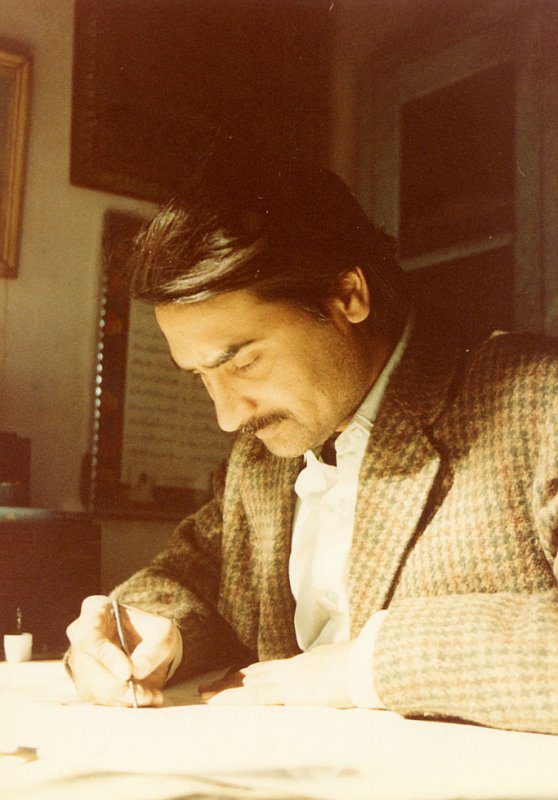
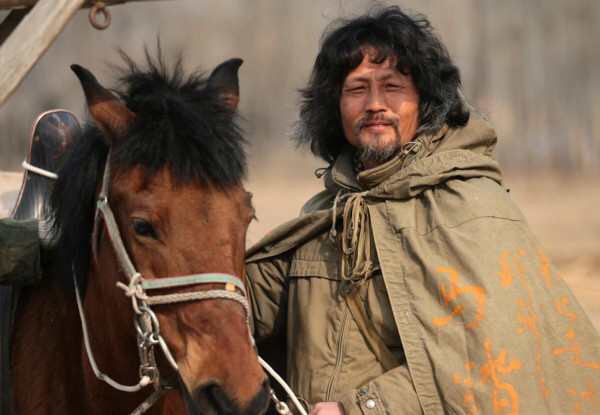
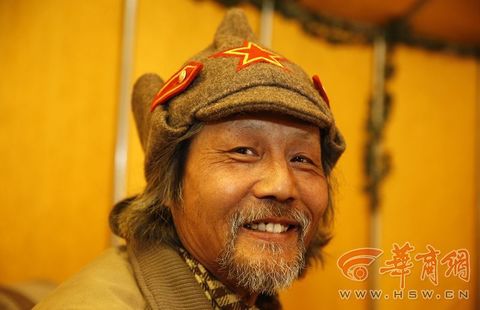
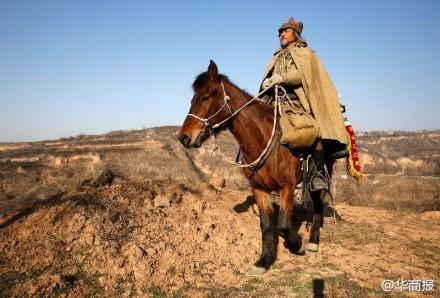
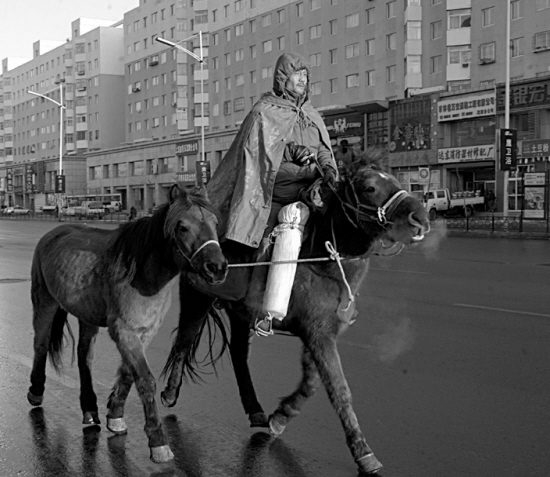
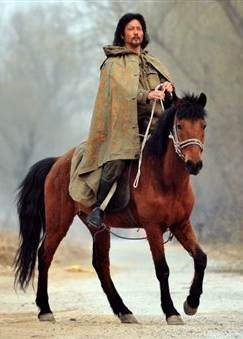
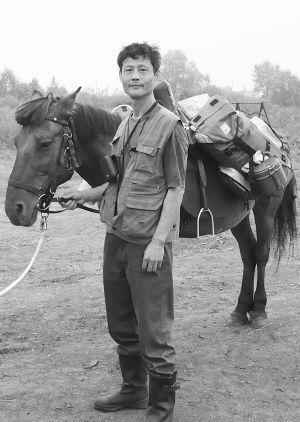
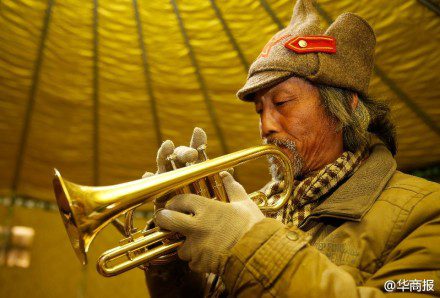
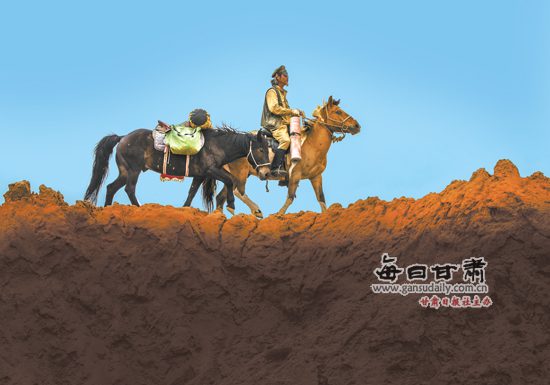
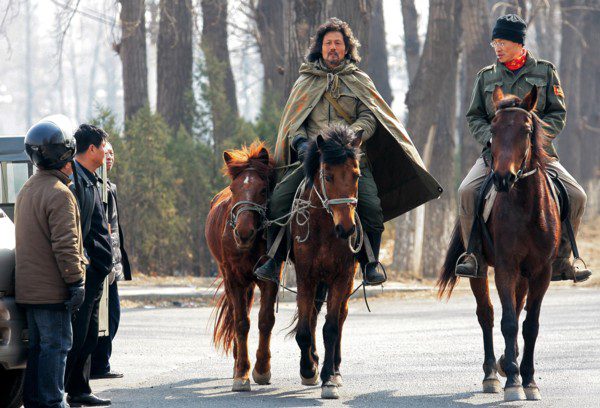








Fascinating article and information.
Please keep your blog updated with this fascinating subject.
Thank you.
What a very fascinating course of events for you Jeff. This truly is exciting!
Fascinating exchange! As I read his reply, Alma 37:6-7 immediately came to my mind, too. I’m so glad you shared it with him! People with those kinds of hobbies are so interesting to talk to!